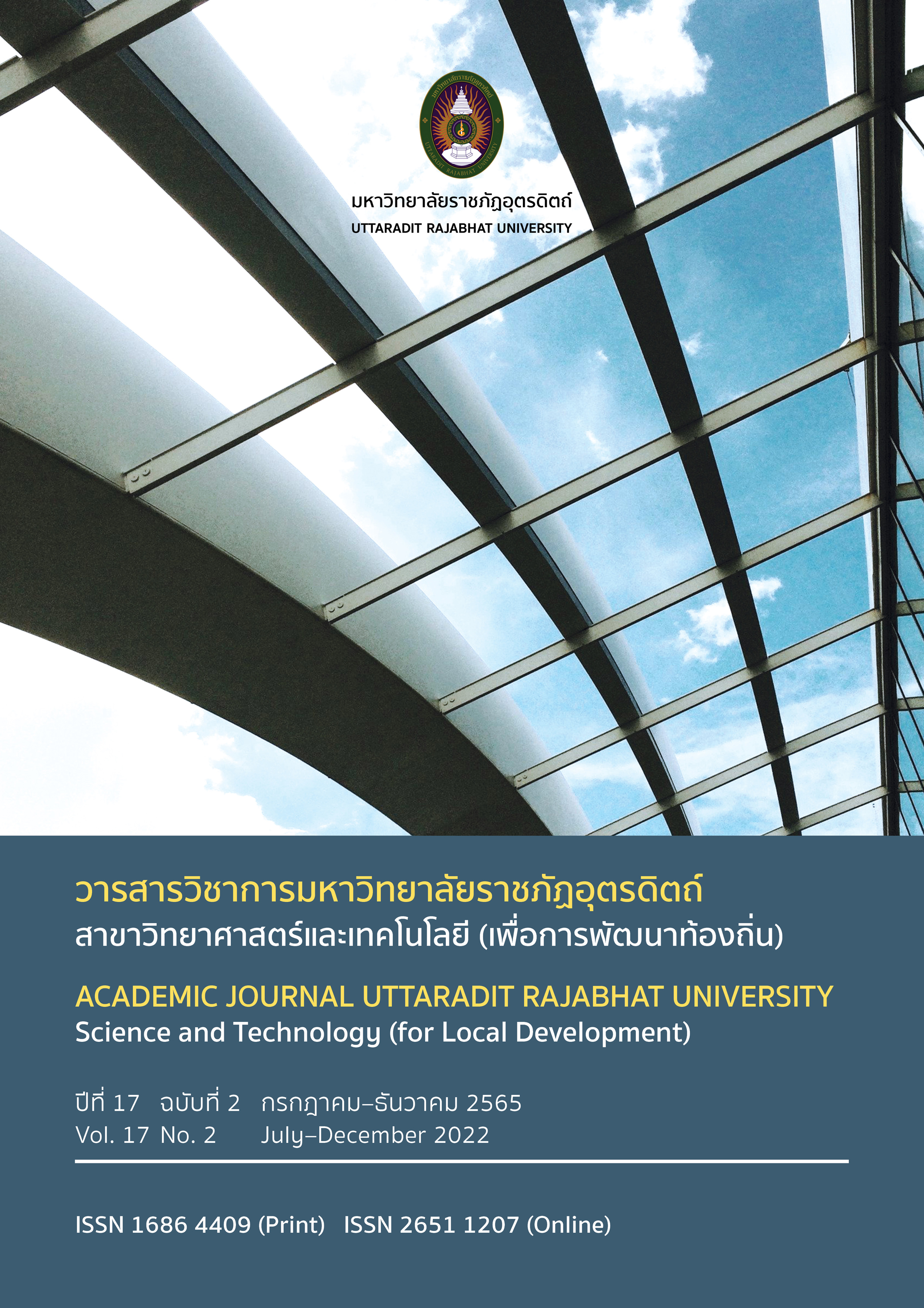EFFECT OF ROASTING TEMPERATURE ON NUTRITIONAL QUALITY AND PHYSICAL CHARACTERISTICS OF CRISPED PORK FAT
Main Article Content
Abstract
The present study aimed to investigate the influence of roasting temperature on nutritional values and physical characteristics of crisped pork fat. It examined the pork fat in the size of 3 5 centimeters which was packed 1 kg per a plastic bag and stored in a container of below -18 ºC. The alternative roastings were conducted at 150, 175, and 200 ºC for 3 hours. Chemical value and physical characteristics were analyzed for total energy including moisture content, protein, ash, fat, carbohydrate contents and water activity as well as the color (CIE), shearing force, and chewing energy. It was found that when higher temperature for roastings was conducted, the fat content and brightness of crisped pork fat (L*) was likely to be lower. In contrast, the crisped pork fat tended to increase the redness (a* value) (p<0,05). Roasting temperature at 200 ºC for 3 hours could increase the highest volume of ash and protein contents. Roasting at 175 ºC could result in the highest increase in yellowness values (b* value) and shear energy at 34.21 and 17.67 N/mm, respectively (p<0,05). The optimum roasting temperature was 175 ºC for 3 hours could give the highest yellowness which could be endorsed as an important quality factor of commercial crisped pork fat.
Downloads
Article Details

This work is licensed under a Creative Commons Attribution-NonCommercial-NoDerivatives 4.0 International License.
References
กรุงเทพธุรกิจออนไลน์. (2563, 21 สิงหาคม). รู้ข้อดีข้อเสียก่อนกิน “น้ำมันหมู” มีคุณค่าทางโภชนาการดีจริงหรือ”. กรุงเทพธุรกิจ มีเดีย จำกัด. https://www.bangkokbiznews.com/lifestyle/894668
ประวิทย์ สันติวัฒนา และธิดา สิริสุขพรชัย. (2559). ผลของการใช้แป้งรำข้าวที่ผ่านการสกัดน้ำมันทดแทนเนื้อหมูในผลิตภัณฑ์หมูบดทอดและคุณภาพของน้ำมันที่ใช้ทอด. วารสารวิทยาศาสตร์และเทคโนโลยี, 24(3), 432-442. https://doi.org/10.14456/tstj.2016.35
ภูมิใจ สอาดโฉม และธนิต สวัสดิ์เสวี. (2557). การอบแห้งเนื้อหมูบดแผ่นด้วยเทคนิคสุญญากาศร่วมกับรังสีอินฟราเรดไกล. วารสารวิชาการ คณะเทคโนโลยีอุตสาหกรรม มหาวิทยาลัยราชภัฏลำปาง, 7(1), 83-97.
สมาคมผู้เลี้ยงสุกรแห่งชาติ. (2565). สถานการณ์อุตสาหกรรมสุกรและแนวโน้มปี 2565. https://www.swinethailand.com/
AOAC. International. (2019). Official methods of analysis of AOAC international (21sted). The Association of Official Analysis Chemists.
Baek, Ki Ho., Utama, Dicky Tri., Lee, Seung Gyu., An, Byoung Ki., & Lee, Sung Ki. (2016). Effects of replacing pork back fat with canola and flaxseed oils on physicochemical properties of emulsion sausages from spent layer meat. Asian-Australasian Journal of Animal Science, 29(6), 865-871. https://doi.org/10.5713/ajas.15.1050
Barretto, A. C. S., Pacheco, M. T. B., & Pollonio, M. A. R. (2015). Effect of the addition of wheat fiber and partial pork back fat on the chemical composition, texture and sensory property of low-fat bologna sausage containing inulin and oat fiber. Food Science and Technology, 35(1), 100-107. https://doi.org/10.1590/1678-457X.6496
Glorieux, S., Steen, L., Van de Walle, D., Dewettinck, K., Foubert, I., & Fraeye, I. (2018). Effect of Meat Type, Animal Fat Type, and Cooking Temperature on Microstructural and Macroscopic Properties of Cooked Sausages. Food and Bioprocess Technology, 12(1), 16–26. https://doi.org/10.1007/s11947-018-2190-6
Kim, Gye-Woong., & Kim, Hack-Youn. (2017). Effects of Carcass Weight and Back-fat Thickness on Carcass Properties of Korean Native Pigs. Korean Journal for Food Science of Animal Resources, 37(3), 385-391. https://doi.org/10.5851/kosfa.2017.37.3.385
Küçüközet, A. O., & Uslu, M. K. (2018). Cooking loss, tenderness, and sensory evaluation of chicken meat roasted after wrapping with edible films. Food Science and Technology International, 24(7), 1-9. https://doi.org/10.1177/1082013218776540
Park, G. B., Moon, S. S., Ko, Y. D, Ha, J. K., Lee, J. G., Chang, H. H, & Joo. S. T. (2002). Influence of slaughter weight and sex on yield and quality grades of Hanwoo (Korean native cattle) carcasses. Journal of Animal Science, 80(1), 129-136. https://doi.org/10.2527/2002.801129x
Powell, T. H., Dikeman, M. E., & Hunt, M. C. (2000). Tenderness and collagen composition of beef semitendinosus roasts cooked by conventional convective cooking and modeled, multi-stage, convective cooking. Meat Science, 55(4), 421-425. https://doi.org/10.1016/s0309-1740(99)00171-0
Wood, J. D., Enser, M., Whittington, F. M., Moncrieff. C. B., & Kempster, A. J. (1989). Backfat composition in pigs: Differences between fat thickness groups and sexes. Livestock Production Science, 22(3-4), 351-362. https://doi.org/10.1016/0301-6226(89)90066-3


